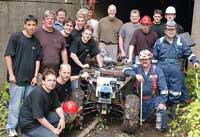 |
| (Photo courtesy of Sebastian Thrun/Carnegie Mellon) |
Researchers at Carnegie Mellon University tested an autonomous robot explorer in an abandoned coal mine May 30 with substantial success. The mechanical beast picked its way, without human guidance, 308 m before fallen debris forced it to turn back.
"Groundhog" uses laser scans to navigate and survey mines. Development was given a push by the Quecreek Mine disaster, in which nine miners were trapped for three days when faulty maps led them to drill into flooded works nearby (ENR 9/16/02 p. 50).
Legacy mines lace the earth in coal country, but records are notoriously unreliable, leading to all-too-frequent blow-outs and cave-ins. Scientists are responding by developing robots that can swim, crawl and drop through the dangerous caverns and return with accurate 3D mapping data.
Photographs and a "movie" of the robot's journey are on the Web at www-2.cs.cmu.edu/~thrun/mines/mathies/index.html. The experiment was the first in which a robot guided itself without a tether or human operator. The descent was flawless and the robots decision to turn back "appropriate," says Red Whitaker, professor of robotics at Carnegie Mellonss school of computer science in Pittsburgh. A software glitch caused a falter on the return leg when the robot was still beyond communications range. Safety officers rescued it by following it in and hitting a reset so it could drive out.
To view video in Quicktime (768K)
To view video in Quicktime (768K)
To view video in Quicktime (768K)
![]() If your computer does not play display these movies properly, please update your QuikTime Software for free at http://www.apple.com/quicktime/download/
If your computer does not play display these movies properly, please update your QuikTime Software for free at http://www.apple.com/quicktime/download/

Post a comment to this article
Report Abusive Comment